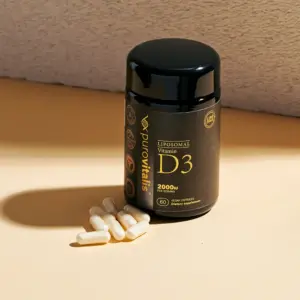
Despite the importance vitamin D has on our health, many people are not getting enough of the nutrient in their diet. In fact, an estimated 1 billion people worldwide have vitamin D deficiency. [1] Luckily, vitamin D deficiency is preventable and treatable. This article covers what you need to know about vitamin D deficiency to ensure you get enough vitamin D each day.
What is vitamin D deficiency?
Vitamin D deficiency means you have an insufficient amount of vitamin D in your body.
Vitamin D plays a major role in bone and immune health. It helps keep the bones strong and prevents age-related bone disorders like osteoporosis. [2] It also helps the immune system fight off illnesses.
The body produces less vitamin D as we age. This puts older adults at an increased risk of vitamin D deficiency, which can lead to bone loss and chronic illness. This is why getting enough vitamin D becomes increasingly important as we age.
Read more on Vitamin D and Immunity here.
How much do I need?
The recommended daily intake of vitamin D varies based on age, geographic location, and individual health conditions. The National Institutes of Health (NIH) suggests a range of 15-20 mcg (600-800 IU) for adults, with higher amounts recommended for older individuals. However, some countries and health organizations recommend higher doses, especially in regions with limited sunlight. A comprehensive review published in the “Journal of Steroid Biochemistry and Molecular Biology” highlights varying global recommendations and underscores the need for personalized assessment based on individual health factors and lifestyle. [3]
What are the signs of vitamin D deficiency?
Not everyone who is vitamin D deficient experiences symptoms. In adults, the most common symptoms are:
- Fatigue
- Muscle aches or cramps
- Bone pain
- Depression
You can also check for Vitamin D deficiencies with our Vitamin D test kit and accurately determine your Vitamin D levels.
Who is most at risk for deficiency?
Various factors can increase your risk of vitamin D deficiency, including:
- Age: Our body makes less vitamin D as we age, which puts people over 65 at an increased risk of vitamin D deficiency.
- Time spent indoors: People who spend most of their time indoors or are unable to get natural sunlight exposure are at an increased risk of vitamin D deficiency.
- Skin color: People with darker skin tones absorb less vitamin D from sunlight than people with fair skin, which puts them at an increased risk of vitamin D deficiency.
How can I increase my vitamin D intake?
There are various ways to increase your vitamin D levels.
First, you can get vitamin D through your diet. Foods that are good sources of vitamin D include cheese, mushrooms, egg yolks, and fish like salmon, tuna, swordfish, and sardines. You can also eat foods that contain fortified vitamin D like milk, cheese, and cereals.
Getting exposure to sunlight is another good way to increase your vitamin D levels. However, the best way to treat vitamin D deficiency is through supplementation.
How long does it take to recover vitamin D deficiency?
Recovering from vitamin D deficiency varies depending on several factors, including the severity of the deficiency, individual health conditions, and consistency in following the treatment plan. Generally, it can take anywhere from a few weeks to several months. A study suggests that taking a higher dose of vitamin D supplements can significantly raise levels within 3-4 months. However, it’s essential to follow a healthcare professional’s advice to determine the appropriate treatment duration and avoid excessive intake, which can be harmful.

How to get vitamin D in winter?
In winter, when sunlight exposure is limited, especially in higher latitudes, you can maintain adequate vitamin D levels through diet and supplements. Foods rich in vitamin D include fatty fish (like salmon and mackerel), egg yolks, and fortified foods like milk, cereals, and some plant-based alternatives. Vitamin D supplements are also a practical option. It’s advisable to consult with a healthcare professional before starting any supplementation.
What are the benefits of Vitamin D and relation to longevity? Read here.
Understanding vitamin D absorption and forms
Vitamin D absorption is a critical aspect of its effectiveness. Factors like gut health, dietary fat intake, and the form of vitamin D supplement can influence absorption rates. Traditional vitamin D supplements might not be fully absorbed, especially in individuals with certain digestive issues. This is where liposomal vitamin D3 becomes significant. Liposomal technology encapsulates vitamin D3 in a fat layer, enhancing its absorption in the body. A study in the “European Journal of Clinical Nutrition” indicates that liposomal encapsulation can improve the bioavailability of nutrients, making them more effective.
Conclusion
As we age, our body’s ability to produce vitamin D decreases. This puts older adults at risk of vitamin D deficiency and its associated effects. Eating foods rich in vitamin D, getting sunlight exposure, and taking a vitamin D supplement are all ways to avoid vitamin D deficiency.
Our top list of science proven anti-aging vitamins can be found here.
References:
- https://www.sciencedirect.com/journal/the-journal-of-steroid-biochemistry-and-molecular-biology
- https://www.ncbi.nlm.nih.gov/pmc/articles/PMC6075634/
- https://www.ncbi.nlm.nih.gov/books/NBK532266/
- https://pubmed.ncbi.nlm.nih.gov/20219962/
- https://www.ncbi.nlm.nih.gov/pmc/articles/PMC10180326/
- https://www.ncbi.nlm.nih.gov/pmc/articles/PMC3782116/
- https://ec.europa.eu/health/scientific_committees/scheer/docs/sunbeds_co109b_en.pdf

Vitamin D3 2000 IU liposomal delivery maximum bioavailability Immune Enhancer
Strengthen your immune system and promote bone health with Liposomal Vitamin D3! Try it out!








